 |
 |
 |
 |
 |
 |
Coincidentally found R color slider in RAW development part of Photoshop CS5. Slided it to full, color turned into yellow. Then I fixed this picture with RAW development only. Maybe this is the way how to get H-alpha color.
Same process for part picture by Nagler 9mm (right).
However, this RAW development step is not works for Silkypix. Different RAW dev engine has different logic.
There was a thin cloud covers sky as Autumn sky. So shutter timing was so difficult to get the sharp picture but anyway I could get with saying bye to the sunspot 1302.
Actually, last 30th was a day when "comet into sun and nexpected explosion happen" which spaceweather.com told. Also it is a day when X-ray Solar Flares reaches to the Earth.
It was missed large sun spot there. At the same time, I sold EOS20Da to get Pentax K-r. Because 8million pixels are too small today and maybe the last chance to sale as a good value. Then I'd like to check K-r for H-alpha picture. By projection shot with PLOSSL 25mm, K-r was not good. However, when I remember I have 3 EOS50Ds because same time panorama shot then bring it out and settled to the telescope. As result, I'm surprised because no newton ring there. After a day of uploaded the pic to the spaceweather.com, I try to the sunspot 1302 which rotated on to the center, again.
No newton ring then how about close-up to the sunspot? I put on Naglar 9mm instead PLOSSL 25mm. Success, again. (photo right)
Then more close-up. I try to use Radian 4mm but it's dark then have to up the ISO or use slower shutter. As result. not so better. Maybe 9mm is a limit.
As reference, the data is only on to the R channel. When we look in the eye-piece, vision is red like photo right.
Only R channel meant resolution is 1/3. No data in B or G. Automatically, final picture size are 1/3 to look better. At 20Da, it was full 3 channels has data as B&W. However, it was only 8 million pixels so 50D has twice. This is not so bad. All these pics are no composite result. So, one shot picture are good because cintillation or Sun's movement of the surface effects.
The sun at the first day of the year again. I felt it is not so good because no sun spot. However, spaceweather.com tells "Dec. 31st around 0110 UTC, something exploded just behind the sun's eastern limb". It is visible at picture left as white dot on the limb.
The old man says, thing which happen twice, it might be happen again. I missed several times but the shutter chance was there again and again at once per each day. So, why not to try it again. I set up telescope with camera again and waited. After got this one, I can say the airplane and sun has no relation with time like frequency. Because it was delay at this morning.
So, patient is only the way to get this even find out the timing as "maybe almost" there.
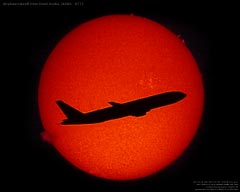 I can see the time table of the airline. However, airliner are not controlling just on time. Any reasons effect to the time usually it's delay or fast.
I can see the time table of the airline. However, airliner are not controlling just on time. Any reasons effect to the time usually it's delay or fast.
By the way, at this morning, it was high cloudy then H alpha are not so fine to take. Then I decided to save RAW and B&W Jpeg together to try to color mode. Canon EOS20Da can save both JPEG and RAW at the same time and even settled as B&W mode, still RAW data is in color mode. As result, I could make more "red" picture (right). This one is not bad, too.
Since I've made airplane shadow with moon, this one was dream. I found maybe I can get 10 days ago coincidentally. So, my painful morning started. Missed airplane every morning. Chance was just once and just like a second.
Why difficult than moon because I can not see airplane coming until it make shadow on the sun. So when find airplane, shutter is too rate to shoot. At the same time, time changes every morning. about 4 minutes earlier than a day before but not same interval. Still I can not figured out the reason why the time changed to the earlier. Even the airline flight are must be different.
Anyway, today, last morning I settled TV85 with Coronado filter again on the Losmandy G8 mount at my home out of the window. Set up the camera, eye drop to the eyes and then waited about 5 minutes - kept my eye on the finder without winking because one wink is enough long to miss the shot. Finally I made this shot - about 5 minutes earlier than morning of yesterday.
Now I have both airplane with moon or sun. :D
* Picture taken as B&W because H-alpha is only red. Use photoshop to made color as H alpha picture. But airplane shadow is not made on photoshop!!
I missed shooting the sun so long. Spaceweather News told the big sunspot 822. So, I bring TV85 then settled it up. EOS20Da gives easy and firm way to get picture like this. The sunspot 822 is enormous. That size is 140,000km!!
I did not took sun photo so long because thinking several way to get different image but could not get goods yet. One of the reason is EOS1DsMk2. However, for the sun, H-Alpha is very important and 20Da is the best.
By Canon EOS 20Da, adjusted with image by research model CCD.
Since I ordered the Canon EOS 20DHa, I had a hard time waiting for it to be delivered so I could see how it works with the SUN H alpha. It was finally delivered today and I put it to the test. I'll let you see the result here.
The picture on the left is in the B&W mode and the composite is the same as usual. The photo below is the RAW mode image. The RAW mode picture shows H-alpha wonderfully.
Actually, the biggest difference is a little bit hard to see in the results because the processing steps were so much easier than the current pictures with the EOS 20D. It didn't feel like the same boosting process for H-alpha. It felt more processing a normal digital photo and then H-alpha just appeared.
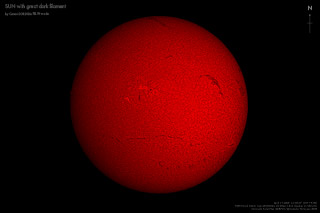 The easiest part was the prominence picture above. I'll try and get a shot of the enlarged part of the prominence someday. The EOS20Da, the added A for Astronomy,is a very good choice to get a picture of the sun using solar filters as the first step. I also tried using the M42 with my FD300mm f2.8L+ FD-EOS + LPS-P1 as a test. With the ISO set at a 400 30second exposure the result is not bad even compared with the pictures I took with the Nikon E5000. At least in my opinion.
The easiest part was the prominence picture above. I'll try and get a shot of the enlarged part of the prominence someday. The EOS20Da, the added A for Astronomy,is a very good choice to get a picture of the sun using solar filters as the first step. I also tried using the M42 with my FD300mm f2.8L+ FD-EOS + LPS-P1 as a test. With the ISO set at a 400 30second exposure the result is not bad even compared with the pictures I took with the Nikon E5000. At least in my opinion.
When I received the camera, I expected to open a box with just an "A" mark on it, just a 20D's box. But I was wrong and happily surprised. This camera comes in its own beautiful printed box. Moreover, the AC adapter AC-E2 and coupler DCDR400 comes with it. Canon really is putting their mind into astronomy photographs and is serious when it comes to putting their astronomy camera on the market. If in the future, the inside filters come as switchable this would be a dream come true for all us astronomy enthusiasts. And then maybe it could also come with a monitor that is possible to remove or rotate?!
NO, NO...Canon, please do not realize this wish so soon! Users like me want to lose ourselves and be happy with our new equipment for a little while longer! After all, the equipment is new on the market and we ordered it just after Canon announced the birth of the 20Da. And why just on the Japanese market...why not worldwide Canon? Don't be so reserved.
Great dark dark filament. That length were more than 300,000 miles, longer than the distance between Earth and Moon. Also solar explosion on right rimb.
Big sunspot 720 still shown on the surface. This sunspot number 720 made problem by unleashed four X-class solar flares to our artificial satellites like NASA's ACE or NOAA's GOES.
Big sunspot 720 with solar prominence right. Nikon E4500 + Radian 18mm. 2 pictures of different shutter speed 1/250 and 1/30 merged on Photoshop.
Big sunspot shown on the surface again. The sunspot number 720 is ging to big one as same as 693 below (spaceweather.com). The weather was cloudy but I made this one to show 720.
Big sunspot shown on the surface. The sunspot number 693 is a wide as planet
Jupiter (spaceweather.com).
04/10/14 PARTIAL SOLAR ECLIPSE
This is a milestone for me. After much time spent setting up for this shot, the end product was like the poster above.I used a Canon 20D in B&W mode. When the eclipse was at it's maximum, the wind was blowing like something out of a movie.Time stamp for above is UTC.
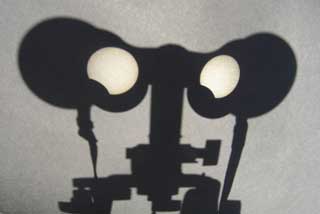 To get the same effect as with the projection and telescope, you can also just use paper and binoculars.This is such an easy and safe method to view the eclipse.
To get the same effect as with the projection and telescope, you can also just use paper and binoculars.This is such an easy and safe method to view the eclipse.
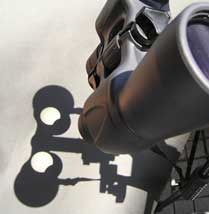
Below are 5 minute intervals with a Nikon E5000. Sorry, some of the shots were missed because of cloud coverage. Time stamps are JST (UTC+9.00).
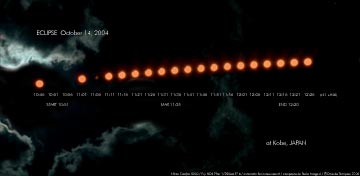 KPS Pro Lens Shade, not currently available on the market, are useful here. Adapt this shade with a UR-E5 + 54mm ring.
KPS Pro Lens Shade, not currently available on the market, are useful here. Adapt this shade with a UR-E5 + 54mm ring.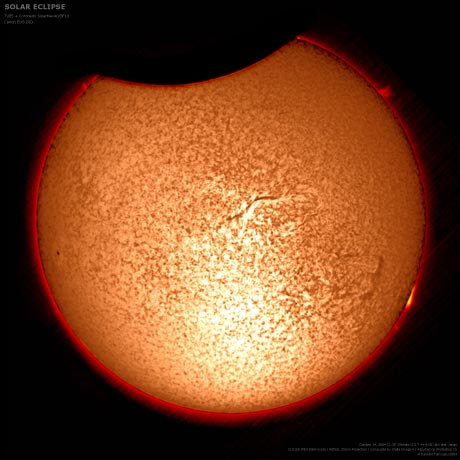 Immediately after the eclipse peaked,I took the shot on the left. I found the edge of the eclipse to be of special interest because I could find no other example like it on the web. The edge becomes brighter with Photoshop and the color adjustments are more red than the others. The actual straight data in RAW mode is just red in color. So, I made this example more true than the fake color made from B&W data. No matter what I used, it still looks like a muffin, don't you think? "Who ate the muffin?"
Immediately after the eclipse peaked,I took the shot on the left. I found the edge of the eclipse to be of special interest because I could find no other example like it on the web. The edge becomes brighter with Photoshop and the color adjustments are more red than the others. The actual straight data in RAW mode is just red in color. So, I made this example more true than the fake color made from B&W data. No matter what I used, it still looks like a muffin, don't you think? "Who ate the muffin?"
By Canon 20D in B&W mode. Dark filaments are not only interesting but also help focusing to take a picture. We can see that the prominence turns a little bit day by day and still No sun spot.Tomorrow will be a partial eclipse for Japan. Hopefully, we'll have good weather.With this kind of H alpha picture I am always wondering whether is it fake or true color when I am processing, because the original picture which is straight from the digital camera is all red.
By Canon 20D in B&W mode again. We can see that the prominence turns a little bit day by day. No sun spot.
20D's B&W mode with an R filter setting works very well with the H alpha picture.
By Canon 20D in B&W mode!!. 20 shots composite on Stella Image 4. Adjusted on Photoshop. Finally, I left the burning American muffin level and reached Champagne Gold. This result is what I was dreaming about.
By Canon 10D. Digital development and adjustment on Photoshop CS. Looks like it finally has the good tone.
A day after I took the photo of M42, just before sunrise. I had to take this picture of a beautiful sun with a prominence arch around it. The shorter ring for my TV85 had arrived but it was still not short enough to get a good focus with a Canon 10D. So, the next try was with BORG #7356 adapter parts which put a BORG SD-2X into a 31.7mm eyepiece holder for projection. Result is on the left. Still, something is wrong, but what?
Composite of the two shots again. The difficulty is adjusting the optical center between the eyepiece and the digital camera. I used TeleVue's digital camera adapter ring only (note: the adapter housing for the eyepiece is impossible to use because Coronado's back filter has a 1.25" sleeve for the eyepiece.) Direct focus with the telescope plus BF10 diagonal is impossible because the focal length is a little bit shorter.
Another composite of two shots at different exposures. It was a little bit cloudy, but the sun appeared between the clouds. For these shots, I connected an E5000 with an eyepiece and very carefully centered the two. After I took this one, the weather became completely cloudy.
Composite of two shots of different exposures which were taken by a Nikon E5000. Just as Mr.Paul Hyndman wrote at his web page, picking up the R layer means reducing 3 layers to 1. Therefore, pixel value of the picture quality are reduced to 1/4 (R=25%, G=50% and B=25%) which is not good. Maybe I will do something (which automatically means I’ll have to make money first....)
* SolarMax has 1.25" diagonal except BF30. So, we can not put in the usual tube for direct focus shooting. This is why only E5000 and not the 10D is up here.
Here a Power Mate 2.5X was used to magnify part of the Sun. Note the beautiful waver prominence. It moves fast but darker than the part of globe exposed for 1 second. I adjusted the difference of the brightness on Photoshop. The light on the edge overflowed to the Blue layer, and then it was erased by hand. It was too much pink , so maybe this is correct, because I can not see any pink edge on other pictures.
Look closely and see that this shot has the mark of the lens polish. Nikon E5000 has a limit for magnitude at this point. For a bright object with a high magnitude, this kind of polish mark comes up. I think this a fault on the standard lens and until the manufacturer changes standards we’ll have this problem. Until the maker changes standards, this will be unavoidable in these special circumstances. Still, “I wanna take the lens out.”!!!!
The web site by Mr.Paul Hyndman has vvery good information about solar picture processing. I found the phrase "H alpha only exists on R layer" and this gave me the big hint to try something. I separated to RGB then picked up R only. There are some exceptions depending on the kind of digital camera or CCD - the signal leaks to the G or B layer. Everything is case by case.
One of the easiest ways to do this with Photoshop is to make the photo visible at R layer only and then change the mode from RGB to grayscale (waste the G or B). After that, process the unsharp and adjust the brightness/contrast and then change to the RGB again. Adjust the color until it looks suitable The hydrogen alpha filter used for the nebula does not work for the Sun because it is not narrow enough. It must be less than 0.7 angstrom. It is also possible to be broken down by heat and not usable. Your own eyes are impossible to replace and have much more quality. I take no responsibility for any trouble.
By the way, we need correct polar alignment to even take pictures of the Sun. Obvioulsy, no stars are up there in the day time. Can you leave your German mount outside until day time? If you have it settled in at night but then you take it down before morning, too bad. I'm using Vixen GP-D with Sky Sensor 2000PC. But, I still feel there are no suitable equipment available to solve this problem. In this GPS era, why do we still have to use the polar star to get fine alignment? No kidding!!!
Copyright©Daisuke Tomiyasu 2004 - 2011